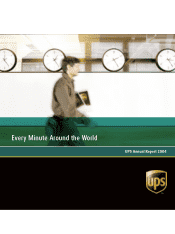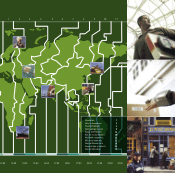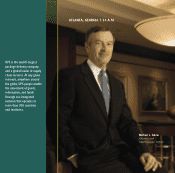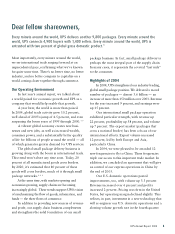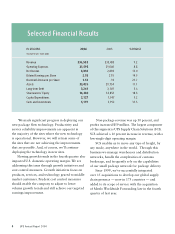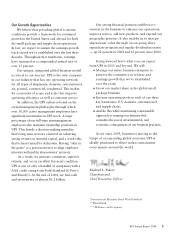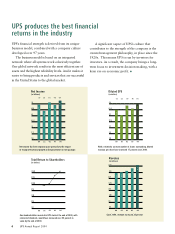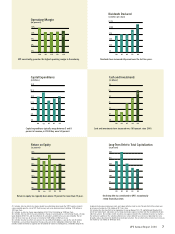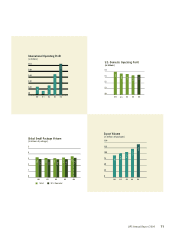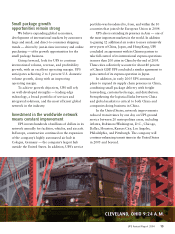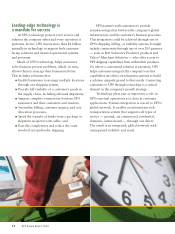UPS 2004 Annual Report Download - page 6
Download and view the complete annual report
Please find page 6 of the 2004 UPS annual report below. You can navigate through the pages in the report by either clicking on the pages listed below, or by using the keyword search tool below to find specific information within the annual report.
ATLANTA, GEORGIA 7:24 A.M.
Chairman and
Chief Executive Officer
We believe that prevailing global economic
conditions provide a framework for continued
growth in the United States and abroad for both
the small package and supply chain operations.
In fact, we expect to sustain the earnings growth
track record we’ve established over the last three
decades. Throughout that timeframe, earnings
have increased at a compounded annual rate of
over 15 percent.
Our unique, integrated global business model
is critical to our success. UPS is the only company
in our industry that has one operating network
for all types of shipments: domestic, international,
air, ground, commercial, residential. This makes
for economies of scope and scale that improve
operating efficiency as well as customer service.
In addition, the UPS culture is based on the
owner/management philosophy through which
over 30,000 active management employees have
significant investments in UPS stock. A large
percentage of our full-time nonmanagement
employees also maintain ownership positions in
UPS. This breeds a decision-making mentality
that’s long-term in focus, centered on achieving
strong returns on invested capital, and a work ethic
that’s characterized by dedication. Having “skin in
the game” is a great motivator to align employee
interests with public shareowners’ interests.
As a result, we generate consistent, superior
returns, and are in excellent financial condition.
UPS is one of only a handful of companies with a
AAA credit rating from both Standard & Poor’s
and Moody’s. At the end of 2004, we had cash
and investments of almost $5.2 billion.
Our strong financial position enables us to
reinvest in the business to enhance our operations,
improve service, add new products, and expand our
geographic presence. It also enables us to increase
shareowner value through an on-going share
repurchase program and regular dividend increases
— up 22 percent in 2004 and 65 percent since 2000.
Going forward here’s what you can expect
from UPS in 2005 and beyond. We will:
n Manage our entire business enterprise to
preserve the consistency in revenue and
earnings growth that we’ve established
over the years;
n Grow our market share in the global small
package business;
n Increase operating profit in each of our three
key businesses: U.S. domestic, international,
and supply chain;
n And do this while maintaining a sustainable
approach to running our business that
considers the social, environmental, and
economic consequences of our business practices.
As we enter 2005, business is moving to the
tempo of an expanding global economy. UPS is
ideally positioned to thrive in this environment
every minute around the world.
Michael L. Eskew
Chairman and
Chief Executive Officer
*International Monetary Fund World Outlook
**World Bank
*** McKinsey and Company
We made significant progress in deploying our
new package flow technology. Productivity and
service reliability improvements are apparent in
the majority of the sites where the new technology
is operational. However, we will retrain some of
the sites that are not achieving the improvements
that are possible. And, of course, we’ll continue
deploying the technology in new sites.
Slowing growth trends in the fourth quarter also
impacted U.S. domestic operating margin. We are
addressing this issue through growth initiatives and
cost control measures. Growth initiatives focus on
products, services, and technology geared to middle-
market customers. Prudent cost control measures
should enable the company to adjust to lower
volume growth trends and still achieve our targeted
earnings improvement.
Non-package revenue was up 10 percent, and
profits increased $59 million. The largest component
of this segment is UPS Supply Chain Solutions (SCS).
SCS achieved a 10 percent increase in revenue, with a
low-single-digit operating margin.
SCS enables us to move any type of freight, by
any mode, anywhere in the world. Through this
business we manage warehouses and distribution
networks, handle the complexities of customs
brokerage, and frequently rely on the capabilities
of our small package network for package delivery.
Since 1999, we’ve successfully integrated
over 15 acquisitions to develop our global supply
chain presence — now in 175 countries — and
added to its scope of service with the acquisition
of Menlo Worldwide Forwarding late in the fourth
quarter of last year.

